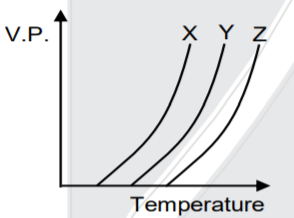What is intermolecular force of attraction? Mention two types of intermolecular force of attraction acting between molecules.
Step-by-Step Solution:
1. Definition of Intermolecular Force of Attraction:
- Intermolecular forces of attraction are the attractive forces that exist between adjacent molecules of a substance. These forces are responsible for holding the molecules together, allowing them to remain close to each other.
2. Understanding the Presence of Intermolecular Forces:
- Intermolecular forces are most prominent in solids, where molecules are tightly packed together. They are less significant in liquids, where molecules are more spaced out, and are negligible in gases, where molecules are far apart.
3. Types of Intermolecular Forces:
- There are two main types of intermolecular forces based on the nature of the molecules involved:
- Cohesive Forces: These are the forces of attraction between molecules of the same type. For example, the forces that hold water molecules together.
- Adhesive Forces: These are the forces of attraction between molecules of different types. For example, the forces that allow water to stick to glass.
Summary:
- Intermolecular forces of attraction are the forces that hold molecules together. They are strongest in solids, weaker in liquids, and negligible in gases. The two types of intermolecular forces are cohesive forces (between same molecules) and adhesive forces (between different molecules).
- Intermolecular forces of attraction are the attractive forces that exist between adjacent molecules of a substance. These forces are responsible for holding the molecules together, allowing them to remain close to each other.
- Intermolecular forces are most prominent in solids, where molecules are tightly packed together. They are less significant in liquids, where molecules are more spaced out, and are negligible in gases, where molecules are far apart.
- There are two main types of intermolecular forces based on the nature of the molecules involved:
- Cohesive Forces: These are the forces of attraction between molecules of the same type. For example, the forces that hold water molecules together.
- Adhesive Forces: These are the forces of attraction between molecules of different types. For example, the forces that allow water to stick to glass.
- Intermolecular forces of attraction are the forces that hold molecules together. They are strongest in solids, weaker in liquids, and negligible in gases. The two types of intermolecular forces are cohesive forces (between same molecules) and adhesive forces (between different molecules).
Topper's Solved these Questions
- CLASSIFICATION OF MATTERBOOK - PEARSON IIT JEE FOUNDATIONCHAPTER - CLASSIFICATION OF MATTEREXERCISE - TEST YOUR CONCEPTS (ESSAY TYPE QUESTIONS)
12 Videos
- CLASSIFICATION OF MATTERBOOK - PEARSON IIT JEE FOUNDATIONCHAPTER - CLASSIFICATION OF MATTEREXERCISE - CONCEPT APPLICATION (LEVEL -1)
44 Videos
- CLASSIFICATION OF MATTERBOOK - PEARSON IIT JEE FOUNDATIONCHAPTER - CLASSIFICATION OF MATTEREXERCISE - TEST YOUR CONCEPTS (VERY SHORT ANSWER TYPE QUESTIONS)
43 Videos
- CHEMISTRY IN DAILY LIFEBOOK - PEARSON IIT JEE FOUNDATIONCHAPTER - CHEMISTRY IN DAILY LIFEEXERCISE - MOCK TEST
25 Videos
- CLASSIFICATION OF MATTERBOOK - PEARSON IIT JEE FOUNDATIONCHAPTER - CLASSIFICATION OF MATTEREXERCISE - ASSESSMENT TEST 2
15 Videos
Similar Questions
Knowledge Check
Intermolecular forces of attraction are more in
AFluorineBIodineCBromineDChlorineWhich of the following is intermolecular force of attraction?
AIonic bondBcovalent bondCmetallic bondingDdipole-dipoleAttractive intermolecular forces are known as
Acentrifugal forcesBvander waal's forcesCnuclear forcesDmechanical forces
Which state of matter has least intermolecular forces of attraction?
View SolutionHow are polymers classified on the basis of intermolecular forces of attraction ?
View SolutionWhat type of intermolecular force leads to high density polymer?
View SolutionWeak Forces (Intermolecular Forces)
View SolutionAttractive intermolecular forces are known as
View Solution

 '
'